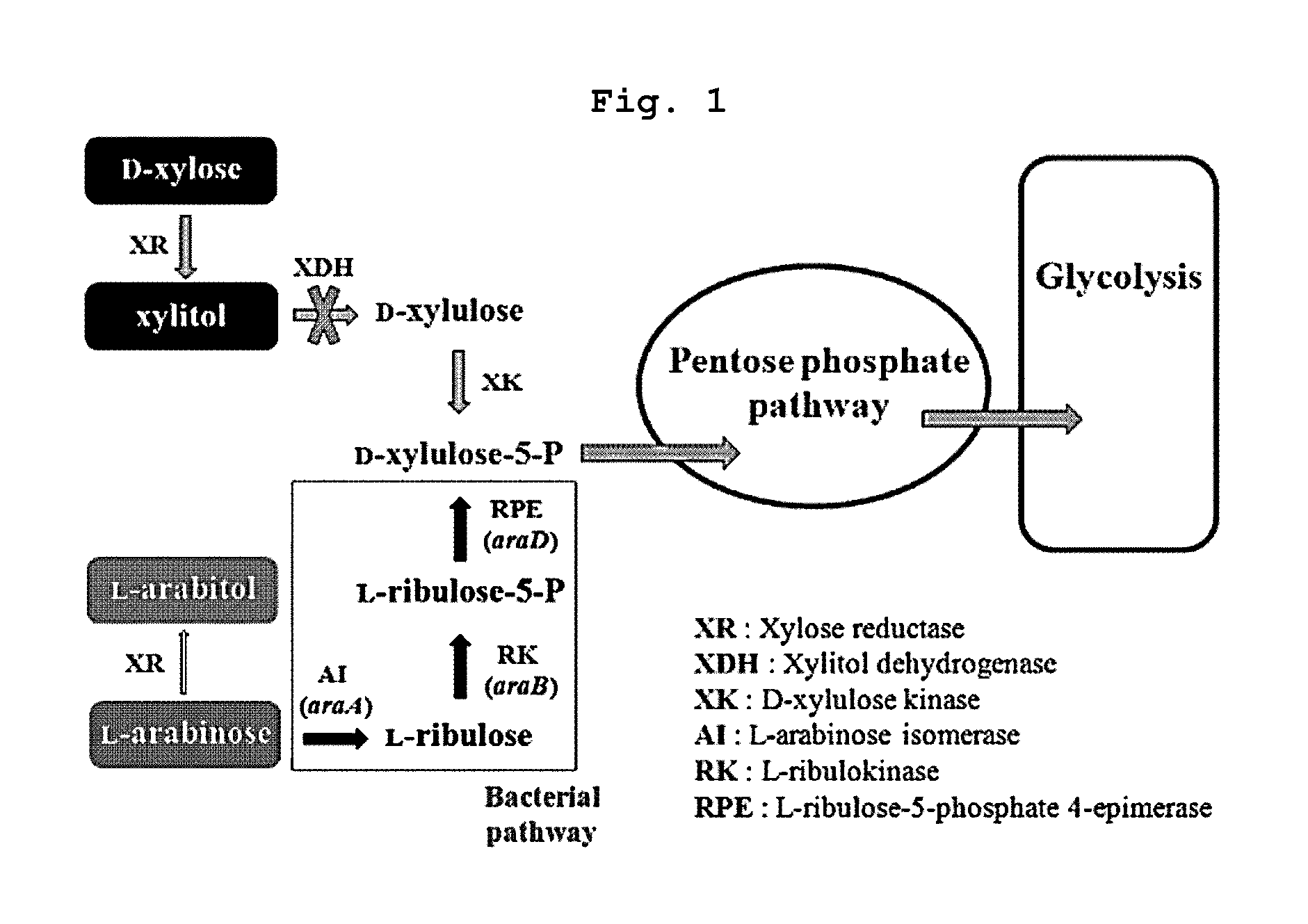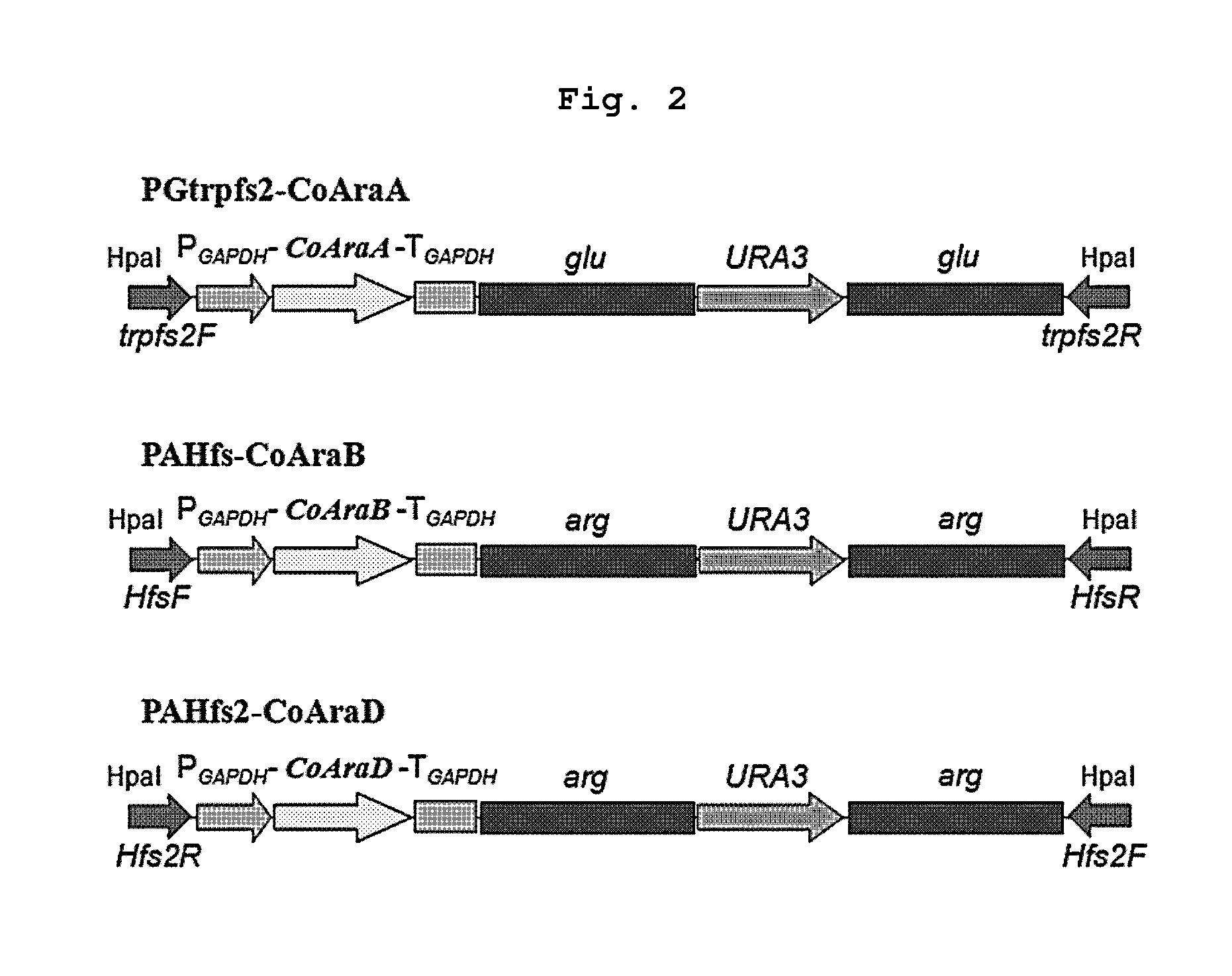Xylitol producing microorganism introduced with arabinose metabolic pathway and production method of xylitol using the same
a technology of xylitol and metabolic pathway, which is applied in the direction of microorganisms, biochemical equipment and processes, fermentation, etc., can solve the problems of high risk and environmental problems, low xylitol recovery rate, and recombinant yeasts that have not been confirmed to be suitable for industrial production, etc., and achieves high productivity and effective use of xylitol production
- Summary
- Abstract
- Description
- Claims
- Application Information
AI Technical Summary
Benefits of technology
Problems solved by technology
Method used
Image
Examples
example 1
Cloning of glyceraldehyde-3-phosphate dehydrogenase Promoter and Terminator
[0066]For the cloning of glyceraldehyde-3-phosphate dehydrogenase (GAPDH) promoter and terminator of Candida tropicalis, PCR was performed by using Candida tropicalis genomic DNA and the following primer set. As a result 1455 bp promoter sequence (SEQ ID NO: 1) and 309 bp terminator sequence (SEQ ID NO: 1) were obtained.
[0067]Promoter PCR [94° C. 30 sec., 30 cycles (94° C. 30 sec., 55° C. 1 min., 72° C. 1 min. 30 sec.), 72° C. 7 min.]:
[0068]
PGAP-F (BglII):(SEQ ID NO: 3)5′-agatctaacgtggtatggttgtaagaaac-3′;andPGAP-R (XbaI_BamHI):(SEQ ID NO: 4)5′-ggatccgcgtctagatgtttaaattctttaattg-3′.Terminator PCR [94° C. 30 sec., 30 cycles(94° C. 30 sec., 55° C. 1 min., 72° C. 1 min.),72° C. 7 min.]:TGAP-F (XbaI_Xho):(SEQ ID NO: 5)5′-tctagattgctcgagctatccaacaaactctag-3′;andTGAP-R (BamHI):(SEQ ID NO: 6)5′-ggatcctctggtttagaagtagggactgtatg-3′.
example 2
Codon Optimization of araA, araB, and araD
[0069]Based on the data of Codon Usage Database (www.kazusa.or.jp / codon / index.html), codons of Bacillus licheniformis L-arabinose isomerase (araA), Escherichia coli L-ribulokinase (araB) and L-ribulose-5-phosphate 4-epimerase (araD) were replaced with the ones preferred by Candida tropicalis. As a result, CoAraA composed of the nucleotide sequence represented by SEQ ID NO: 7, CoAraB composed of the nucleotide sequence represented by SEQ ID NO: 8 and CoAraD composed of the nucleotide sequence represented by SEQ ID NO: 9 were synthesized (GENEART, Germany).
example 3
Construction of CoAraA, CoAraB and CoAraD Expression Cassettes and Expression Strains
[0070]The optimized genes synthesized in Example 2 were cloned in the cassette containing the promoter of glyceraldehyde-3-phosphate dehydrogenase and the repetitive sequence (glu or arg gene) for the elimination of selection marker. As a result, PGtrpfs2-CoAraA, PAHfs-CoAraB and PAHfs2-CoAraD were obtained (FIG. 2).
Construction of Transformed Candida tropicalis in which Xylose Dehydrogenase Expression is Inhibited
[0071]PCR was performed by using Candida tropicalis genomic DNA as a template with the below primers [94° C. 1 min., 25 cycles (94° C. 30 sec., 58° C. 30 sec., 72° C. 30 sec.), and 72° C. 3 min.] to amplify Candida tropicalis xylitol dehydrogenase gene. The amplified Candida tropicalis xylitol dehydrogenase gene was cloned into pGEM-T easy vector (BIONEX, Korea), followed by the introduction of BamHI site in the middle of the xylitol dehydrogenase gene. On the region of introduced BamHI, ...
PUM
| Property | Measurement | Unit |
|---|---|---|
| temperature | aaaaa | aaaaa |
| concentration | aaaaa | aaaaa |
| concentration | aaaaa | aaaaa |
Abstract
Description
Claims
Application Information
 Login to View More
Login to View More - R&D
- Intellectual Property
- Life Sciences
- Materials
- Tech Scout
- Unparalleled Data Quality
- Higher Quality Content
- 60% Fewer Hallucinations
Browse by: Latest US Patents, China's latest patents, Technical Efficacy Thesaurus, Application Domain, Technology Topic, Popular Technical Reports.
© 2025 PatSnap. All rights reserved.Legal|Privacy policy|Modern Slavery Act Transparency Statement|Sitemap|About US| Contact US: help@patsnap.com


